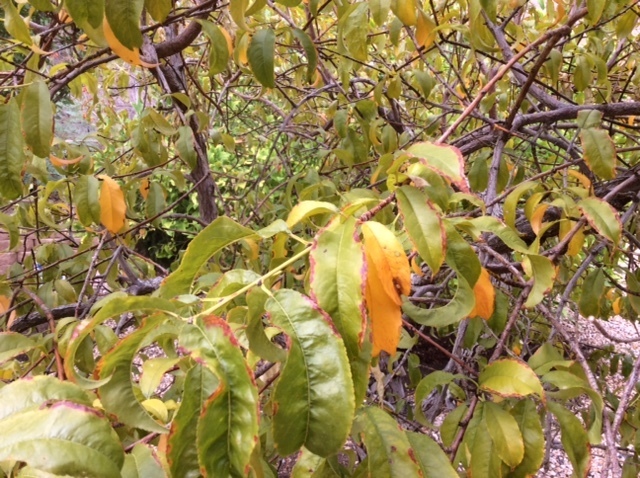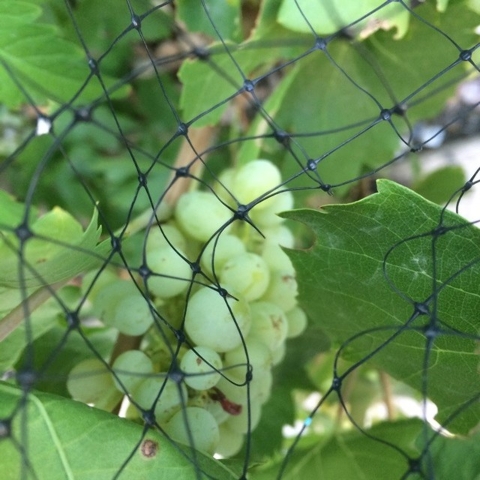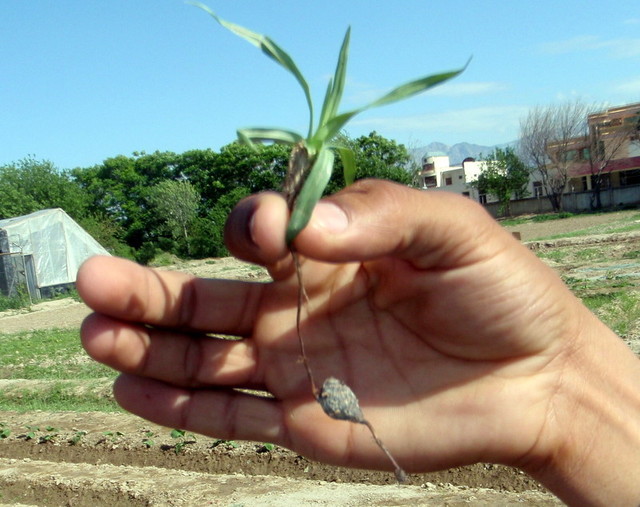Peach tree with yellow leaves needs more water
Q: I have a new Early Grande peach which produced more than 80 blossoms. I removed 50 of the fruit when they were small and harvested the rest when the fruit ripened. Now the leaves are turning yellow and dropping off. I am watering the tree for 40 minutes, three times a week so the tree is getting 16 gallons a week.
A: If your peach tree is getting yellow leaves, they are dropping and the canopy is sparse (not very many leaves), it probably needs more water applied each time you water. Leaf yellowing and drop is common when the tree is not getting enough water.
If the soil is bare, watering fruit trees every other day for new trees during the heat sounds about right for most of our soils. But the amount you are applying does not seem enough to me.
If the soil is covered with a 3- to 4-inch layer of mulch on the surface, then you should be able to squeeze two to three days between irrigations, provided enough water is applied.
Make sure the applied water is wetting the soil 18 to 24 inches deep. Use a metal rod, rebar or long screwdriver to judge the depth of the watering. Push it into the soil after watering and see when it is hard to push anymore.
Peach trees that are 7 feet tall and 7 feet wide should receive about 90 gallons of water each week. This can be applied with drip irrigation or a level basin built around the tree about 6 feet in diameter and 4 inches deep.
Just like fig or any other fruit tree for that matter, peach tree growth improves with a surface mulch and the leaves will stop dropping.
The term “too much water” has a double meaning. Too much water can mean too much water is applied at a single time. Too much water can also mean water applied is too often. Watering too often is more damaging to plants than giving it too much water in a single application.
Enough water should be applied to wet the soil around all the roots. This amount of water remains constant 12 months a year. However, how often to water changes season to season and sometimes month to month.
Plants use 500 to 800 percent more water in July and August than they do in January in our desert climate. This increase is done primarily by watering more often, not increasing the minutes.
Q: I sent you three pictures of our grapevines. We have been getting a few bunches of grapes but they are small and bitter. How do we get them to get them larger and sweeter?
A: Many grapes do well in our Mojave Desert climate. Some grapes perform better than others. Some great varieties perform much better than others. I noticed you did not mention which variety you have which makes me a little suspicious.
A big problem with grapes in our hot desert climate is uneven ripening of the berries growing in a bunch. Berries that are fully ripe will be sweet. Berries that have not ripened will be sour or stringent. Our hot desert climate is good for producing sugar if fruit is fully ripe.
Uneven ripening means some berries will ripen earlier than others. The ones that don’t ripen will be bitter. We see the ripening of the berries as a change in its color. Technically this is called veraison.
It is easy to see the color change for black, purple, red or blue grapes. It is more difficult to see the color change in green grapes. Green grapes turn from green to golden green when they are ripe.
In our heat, it is common for the ripe berries to be scattered among tart, immature berries. Uneven ripening can be a problem with grapes in general but in climates with high temperatures it is more of a problem.
In cooler climates, particularly with cooler nights, berries mature more evenly with fewer unripe berries. Make sure that you have a variety of grape that ripens well here.
Your vines look healthy but healthy vines do not necessarily deliver a delicious grape. Make sure you wait long enough so that as many berries as possible fully mature.
My suspicion is either a variety that does not perform well in our climate or you are not waiting long enough before harvesting. Harvest the bunches when a small percentage are overripe. Once grapes are harvested, they no longer ripen unlike plums, peaches and even bananas.
For larger berries, you must reduce the total number of berries produced by a single vine. By reducing the total number of berries, the remaining berries get larger.
The number of berries are reduced by removing entire bunches of grapes and trimming the remaining bunches to eliminate the bottom one-third of the cluster. This is done in mid-spring when the berries are the size of BBs.
Q: I have a healthy 10-year-old yucca tree in my desert landscaped yard. The homeowner before me watered it daily in summer and weekly in winter and did so for many, many years. I continued that practice but have read that yuccas should not have daily watering. Since everything looks healthy and vibrant, would it be OK to continue daily watering in summer?
A: Exactly right. They are not supposed to be watered this way. However, it appears the previous owner found a happy medium between watering frequently and not damaging the plant.
My guess is the tree was getting very small amounts of water daily. I would not worry about it if the plants are doing OK, and I wouldn’t change anything.
However, you should be aware that you are doing it entirely wrong but it’s working. Be careful if you change anything because these plants are now adjusted to that watering schedule.
Q: We have a large garden in an area that used to be underwater. The soil is dark, has very small particles, and it clumps like clay. It also has nutgrass.
We tried several ways to get rid of it and so far none have been successful. The soil needs amendment, and we are wondering if digging up this weedy patch, disposing of it and replacing it with compost and topsoil would fix the problems or if there is a better solution.
A: Yes, nutgrass is an important weed in rice paddies. Very difficult to control. It is a sedge that produces an underground nut that easily separates from the mother plant when the aboveground part is pulled.
This nut produces an entire new plant when separated from the mother plant. When hoeing nutgrass, burning the tops with fire or using weed killers, the tops die but the nuts regenerate a new plant.
These nuts are located maybe 6 to 12 inches deep. Removing the soil to this depth should remove nearly all of the nuts. This soil can be replaced with a clean soil.
Research has shown you can eventually exhaust these nuts and the nutgrass if you continuously remove the tops. Continually removing the tops eventually exhaust the underground nut.
The tops must be removed when the nut has produced four new aboveground leaves. Waiting longer than this, the plant begins rebuilding the exhausted nut. Removing them sooner will not exhaust the nut fast enough.
There will be a decrease in nutgrass the first year. Every year the population of plants will get smaller and smaller.
Bob Morris is a horticulture expert living in Las Vegas and professor emeritus for the University of Nevada. Visit his blog at xtremehorticulture.blogspot.com. Send questions to Extremehort@aol.com.






























